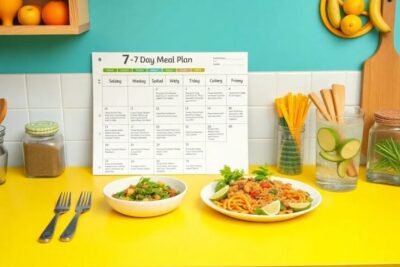
Delicious Diabetic-Friendly Meals for Type 1 Diabetes
- Understanding Type 1 Diabetes
- The Importance of Meal Planning
- Key Nutritional Components for Diabetic Meals
- Breakfast Ideas to Kickstart Your Day
- Lunch Options That Satisfy
- Wholesome Dinner Recipes for All Family Members
- Snacks That Won't Spike Your Blood Sugar
- Hydration: The Unsung Hero of Diabetes Management
- Tips for Eating Out with Type 1 Diabetes
Understanding Type 1 Diabetes
Type 1 diabetes is a chronic condition that results from the autoimmune destruction of insulin-producing beta cells in the pancreas. Unlike Type 2 diabetes, where insulin resistance is the primary concern, individuals with Type 1 diabetes face an absolute deficiency of insulin. This deficiency necessitates lifelong management through insulin therapy, as the body cannot produce sufficient amounts of this critical hormone. As a result, maintaining stable blood glucose levels requires diligent monitoring and the adoption of a carefully considered dietary approach.
Dietary management is integral to effective diabetes care, particularly for individuals with Type 1 diabetes. A well-balanced diet that incorporates diabetic friendly meals can help regulate blood sugar levels and provide essential nutrients. The carbohydrate content in meals must be monitored closely, as carbohydrates have a direct impact on blood glucose levels. Foods that are high in fiber, lean proteins, and healthy fats are considered beneficial. Consuming a variety of these food groups not only supports overall health but also contributes to optimal glycemic control.
Individuals with Type 1 diabetes often have unique nutritional needs that can differ significantly from those without the condition. It is crucial for them to engage with healthcare professionals, such as dietitians, who can tailor dietary recommendations based on personal preferences, lifestyle, and metabolic responses. A focus on diabetic friendly meals, which are balanced and include appropriate portions, enables better management of glucose levels and promotes a healthy lifestyle. In this context, being informed about food choices and their nutritional impact plays a pivotal role in maintaining health and preventing complications associated with Type 1 diabetes.
The Importance of Meal Planning
Meal planning plays a crucial role in managing Type 1 diabetes, as it directly influences blood sugar control and overall well-being. For individuals living with Type 1 diabetes, the necessity for a balanced diet is paramount, which can be achieved through well-structured meal preparation. By planning meals ahead, individuals can ensure that they incorporate diabetic-friendly meals that are both nutritious and satisfying, ultimately steering clear of the risks associated with impulsive eating choices.
One of the significant benefits of meal planning is its contribution to maintaining stable blood glucose levels. When meals are prepared in advance, individuals have the opportunity to select ingredients that score low on the glycemic index, ensuring that blood sugar spikes are minimized. A well-planned menu allows for optimal carbohydrate counting, a critical practice for Type 1 diabetics. By calculating carbohydrate intake, individuals can time their insulin administration effectively, reducing complications that may arise from erratic eating habits.
In addition to aiding in blood sugar management, meal planning can alleviate stress. Knowing what to prepare eliminates last-minute decisions that often lead to unhealthy choices. Having a variety of diabetic-friendly meals, which encompass lean proteins, healthy fats, and ample vegetables, readily available encourages healthier eating patterns. It promotes the consumption of diverse foods, which is vital for attaining a well-rounded nutrient profile necessary for optimal health.
Furthermore, meal planning can also boost motivation. Preparing meals in advance allows individuals to experiment with different recipes and flavors, keeping their diet exciting and enjoyable. This guideline ensures adherence to nutritional goals and encourages the inclusion of whole, unprocessed foods, which can significantly enhance the quality of life for those with Type 1 diabetes.
Key Nutritional Components for Diabetic Meals
When planning diabetic-friendly meals, especially for individuals with type 1 diabetes, it is essential to focus on the key nutritional components that can help in managing blood sugar levels effectively. Understanding carbohydrates, proteins, and fats lays the groundwork for a balanced diet that supports overall health.
Carbohydrates are a primary concern for diabetics due to their direct impact on blood sugar. It is pivotal to choose complex carbohydrates, such as whole grains, legumes, and vegetables, which tend to have a lower glycemic index (GI). Foods with a lower GI release glucose into the bloodstream more slowly, helping to prevent spikes in blood sugar levels. Simple carbohydrates, like sugary snacks and white bread, should be limited as they can lead to rapid elevations in glucose levels. Planning meals with an emphasis on low-GI options can significantly benefit individuals managing type 1 diabetes.
Proteins play a crucial role in diabetic-friendly meals as they help maintain muscle mass and promote satiety, which can aid in weight management. Including lean sources of protein such as chicken, fish, tofu, and legumes can add nutritional value without adversely affecting blood sugar levels. Additionally, healthy fats can complement a diabetic-friendly diet; sources like avocados, nuts, and olive oil provide essential fatty acids that support heart health while keeping meal plans balanced. However, the intake of saturated and trans fats should be limited to avoid complications related to cardiovascular health, which is a common concern in diabetic patients.
Lastly, dietary fiber is a vital component that cannot be overlooked. High-fiber foods not only improve digestion but also help in regulating blood sugar levels. Incorporating beans, vegetables, and whole grains can increase fiber intake and slow down carbohydrate absorption. By focusing on these key nutritional elements, individuals with type 1 diabetes can create delicious, balanced meals that contribute to overall health and effective blood sugar management.
Breakfast Ideas to Kickstart Your Day
Starting the day with a nutritious breakfast is essential for individuals managing type 1 diabetes. The right combination of proteins, healthy fats, and carbohydrates can provide sustained energy and help maintain stable blood glucose levels. Here are some diabetic-friendly meal options that are both delicious and healthful.
One popular breakfast idea is a vegetable omelet made with eggs or egg whites, loaded with nutrient-dense vegetables such as spinach, bell peppers, and tomatoes. This meal is high in protein and fiber, which are crucial for managing diabetes. Pairing the omelet with a slice of whole-grain toast offers a balanced source of carbohydrates to fuel your day.
Another option is Greek yogurt topped with fresh berries and a sprinkle of nuts or seeds. Greek yogurt is an excellent source of protein, and berries provide antioxidants along with low-glycemic carbohydrates. This combination supports a healthy digestive system and keeps your blood sugar levels steady. When choosing yogurt, opt for unsweetened varieties to minimize added sugars.
For those seeking something warm, consider oatmeal prepared with almond milk. Use rolled oats to create a hearty porridge, and add toppings such as chia seeds or a small amount of cinnamon for extra flavor. Oatmeal is rich in soluble fiber, which can improve insulin sensitivity and promote a feeling of fullness.
Finally, smoothies can be a great breakfast alternative. Blend leafy greens, a small portion of fruit, protein powder, and a healthy fat source such as avocado or nut butter. This diabetic-friendly meal maintains a proper balance of macronutrients while providing essential vitamins and minerals.
Incorporating these ideas into your morning routine can help you make satisfying and nutritious choices. Always pay attention to portion sizes and food selections to ensure that your meals are conducive to managing type 1 diabetes effectively.
Lunch Options That Satisfy
For those managing Type 1 diabetes, lunch presents an opportunity to enjoy meals that are both flavorful and fulfilling, while also adhering to dietary needs. Opting for diabetic-friendly meals type 1 can help maintain blood glucose levels without sacrificing taste. Here are some nutritious lunch options that are simple to prepare and packed with essential nutrients.
One excellent choice is a quinoa salad, which provides a great source of protein and fiber. Prepare it by mixing cooked quinoa with chickpeas, diced cucumbers, cherry tomatoes, and a light lemon vinaigrette. This salad is not only refreshing but also versatile; you can add different vegetables or proteins based on preference. The high fiber content helps with digestion and plays a crucial role in regulating blood sugar levels.
Another appealing option is a whole grain wrap filled with lean turkey, spinach, and avocado. This balanced meal is easy to assemble and rich in healthy fats and essential vitamins. Whole grains support better blood sugar management and provide a sustained release of energy, making them a clever choice for a midday snack or lunch.
For those who enjoy warm meals, grilled vegetable and chicken stir-fry is an ideal selection. By using a variety of colorful vegetables such as bell peppers, broccoli, and snap peas, individuals can craft a hearty dish that is satisfying and flavorful. Including lean chicken breast not only adds protein but also makes the meal more filling.
Finally, lentil soup is a warming option that is both nutritious and diabetic-friendly. Lentils are an excellent source of complex carbohydrates, which provide sustained energy and help stabilize blood sugar. Pairing the soup with a slice of whole-grain bread makes it a complete meal, offering essential nutrients and flavors that cater to individuals managing Type 1 diabetes.
Wholesome Dinner Recipes for All Family Members
Preparing meals that cater to the dietary requirements of individuals with Type 1 diabetes while appealing to the entire family can be both enjoyable and rewarding. When considering diabetic-friendly meals for Type 1 diabetes, it is important to incorporate fresh ingredients, balanced nutrition, and flavors that please everyone at the table. This ensures inclusivity and promotes healthy eating habits for the whole family.
One excellent option for dinner is a quinoa and vegetable stir-fry. Start with sautéing colorful vegetables such as bell peppers, broccoli, and carrots in a bit of olive oil. Quinoa serves as a great base due to its high protein content and low glycemic index, making it a suitable choice for diabetic-friendly meals. Season the mixture with herbs and spices instead of relying on heavy sauces, which can add unnecessary sugars. This dish is not only nutritious but also visually appealing, making it a hit with children and adults alike.
Another family-friendly recipe is baked salmon paired with a side of roasted sweet potatoes and asparagus. Salmon is rich in omega-3 fatty acids, which offer numerous health benefits. Sweet potatoes provide complex carbohydrates that are absorbed more slowly, helping to maintain stable blood sugar levels. Season the salmon with lemon, garlic, and herbs for added flavor that can entice the entire family, while keeping in mind the dietary needs of those who require diabetic-friendly meals.
A final suggestion is a hearty vegetable and bean chili. Utilize canned beans, tomatoes, and a variety of spices to create a chili that is rich in fiber and flavor. This meal can be prepared in bulk and is excellent for leftovers, making it a convenient option. When served with a side of whole-grain bread or brown rice, this dish satisfies all family members while remaining compliant with diabetic dietary guidelines. Ultimately, creating meals that are both inclusive and nutritious is essential for fostering a positive dining experience.
Snacks That Won't Spike Your Blood Sugar
Individuals with Type 1 diabetes often seek nutritious and enjoyable snacks that support stable blood sugar levels. Choosing the right snacks is crucial for managing diabetes, as it not only impacts energy levels but also overall well-being. Therefore, selecting diabetic friendly meals type 1, which include snacks, requires attention to ingredients and portion sizes.
One effective approach is to opt for snacks that balance carbohydrates with protein and healthy fats. For example, pairing an apple with almond butter creates a satisfying snack that provides dietary fiber along with protein, helping to keep blood sugar levels stable. Other excellent options include Greek yogurt topped with nuts, or hummus served with vegetable sticks. These combinations ensure that snacks are not only delicious but also contribute to a balanced diet.
Portion sizes play a vital role in blood sugar management. It is essential to be mindful of how much is consumed in one sitting. Using measuring cups or kitchen scales may help individuals control portion sizes, allowing for better blood sugar regulation. Snacks such as whole grain crackers, seeds, or popcorn can be healthful but should be eaten in moderation to avoid excessive carbohydrate intake. Timing of these snacks is equally significant; incorporating them between meals can help prevent hunger while managing blood glucose levels effectively.
When shopping for snacks, checking labels for added sugars and refined carbohydrates is crucial. Ingredients such as artificial sweeteners or trans fats should be avoided. Instead, look for whole food options, which are typically lower in glycemic index and offer better nutritional value. By carefully selecting wholesome snacks and being aware of portion sizes, individuals can enjoy a variety of options while adhering to a diabetic-friendly eating plan that complements their lifestyle.
Hydration: The Unsung Hero of Diabetes Management
Proper hydration is often overshadowed by diet and exercise in the management of Type 1 diabetes, yet it plays a critical role in maintaining overall health and optimal blood sugar levels. For individuals with Type 1 diabetes, ensuring an adequate intake of fluids is essential, as it can assist in regulating blood glucose levels and reducing the risk of dehydration, which is common in this population due to the potential for increased urination caused by high blood sugar levels.
When planning diabetic-friendly meals, attention must also be given to fluid choices. Beverages that are free from sugar and high in calories should be prioritized. Water remains the best option, as it contains no calories, sugar, or carbohydrates. In addition to plain water, diabetic-friendly beverages such as unsweetened herbal teas and infused water with fruits or herbs can add variety and flavor without compromising health. For instance, beverages like cucumber-infused water or peppermint tea offer refreshing alternatives that can help with hydration while being low in calories.
It’s important to also consider the effects of caffeine and alcohol, as both can lead to dehydration when consumed in excess. Moderation is key when integrating these drinks into a diabetic's diet. It is beneficial to pair caffeinated beverages with plenty of water, and when it comes to alcohol, opting for sugar-free mixers can also make them a safer choice for those managing Type 1 diabetes.
Furthermore, staying properly hydrated has the added benefit of supporting kidney function, which is particularly crucial for individuals with diabetes. By maintaining hydration, individuals may experience improved circulation, enhanced digestion, and even better cognitive function. Given these benefits, hydration should be seen as an integral part of any diabetes management plan, complementing dietary choices, including diabetic-friendly meals designed specifically for Type 1 diabetes.
Tips for Eating Out with Type 1 Diabetes
Dining out can be a delightful experience, but for individuals with Type 1 diabetes, it can also present certain challenges. Making healthy choices while enjoying a meal away from home requires strategic planning and awareness. Here are some practical tips to ensure that dining out aligns with your diabetic-friendly meals objectives.
First, it is advisable to review the restaurant's menu in advance. Many establishments provide menus online, allowing you to identify diabetic-friendly meal options ahead of time. Seek out dishes that are rich in whole grains, lean proteins, and plenty of vegetables, as these components contribute to balanced, diabetic-friendly meals. At the same time, be mindful of high-sugar sauces, fried foods, or items heavy in refined carbohydrates, which can adversely affect blood sugar levels.
When you arrive at the restaurant, consider communicating openly with your server about your dietary needs. It is important to inform them that you are looking for options that are suitable for Type 1 diabetes. Your server may be able to suggest modifications to existing dishes or recommend menu items that better align with your nutritional requirements. For instance, you might ask for dressings and sauces on the side, substitutions for high-carb sides, or the use of less oil during cooking.
Portion control is another essential aspect of enjoying meals while managing diabetes. Restaurant portions are often larger than necessary. Share dishes with a dining companion or consider ordering a smaller appetizer as your main meal. Additionally, always keep an eye on carbohydrate content, and utilize a carbohydrate count tool if needed to make informed decisions. By incorporating these strategies, you can savor the pleasures of dining out while maintaining a commitment to healthy choices.










